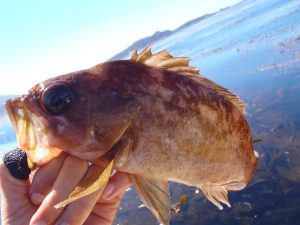 We’ve been fishing all summer for both juvenile and adult rockfishes and are nearing the end of our major field season. So far this year, we’ve caught, clipped and released 789 fish! Though only 319 of these were kelp rockfish (Sebastes atrovirens), our target species, we’re well on our way to 5,000 samples. Kind of. We’re doing final preparations for a training event to get the recreational fishing community involved in the project – if we’ve learned anything this season its that 5,000 kelp rockfish is ALOT of hook and line fishing, even with an army of eager undergrad volunteers.
We’ve been fishing all summer for both juvenile and adult rockfishes and are nearing the end of our major field season. So far this year, we’ve caught, clipped and released 789 fish! Though only 319 of these were kelp rockfish (Sebastes atrovirens), our target species, we’re well on our way to 5,000 samples. Kind of. We’re doing final preparations for a training event to get the recreational fishing community involved in the project – if we’ve learned anything this season its that 5,000 kelp rockfish is ALOT of hook and line fishing, even with an army of eager undergrad volunteers.
It may sound like we’ve been relaxing on boats all summer. We have. Fortunately for us, its all in the name of science. A group of scientists (Mark Carr, UCSC; Carlos Garza, NOAA NMFS; and Chris Edwards, UCSC) are leading an in-depth exploration of juvenile rockfish dispersal on the central CA coast. While we understand the rockfish life-cycle very well (live birth, 2-5 month pelagic larval phase, recruit to kelp forests), we lack a complete understanding of the factors that determine why juvenile rockfish settle where they do. We aren’t yet able to predict where a juvenile rockfish produced at a certain time and place will end up or estimate average geographic distance of larval dispersal. Though there are many methods for determining where a juvenile fish came from (chemical tracers, otolith microchemistry analysis, physical tagging), we’re using genetic parentage analysis. If we can match an adult fish (caught in a known location) to a juvenile fish (which settled to a known location), we’ve very accurately recorded dispersal direction and distance. In order to give ourselves a fair chance of sampling both an offspring AND a parent fish, we’re aiming to catch 5,000 adult kelp rockfish and as many juvenile kelps as possible (see post on SMURFing). Because there are many physical variables that are influencing the movement of pelagic rockfish larvae – ocean currents, upwelling regime, sea temperature – we’re working with ocean modelers to better understand why juveniles end up where they do. A better understanding of rockfish dispersal dynamics will allow more informed decision-making regarding the location and size of marine protected areas designed to increase rockfish population sizes.